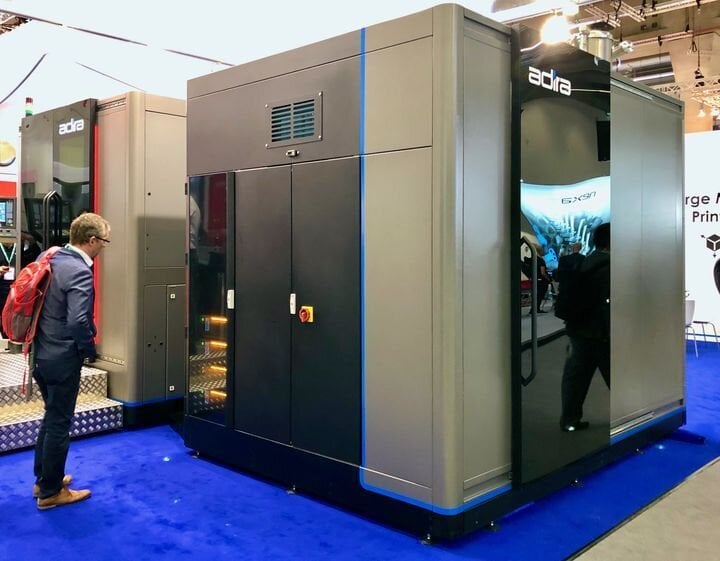![The enormous Addcreator from ADIRA [Source: Fabbaloo]](https://fabbaloo.com/wp-content/uploads/2020/05/image-asset_img_5eb08b9d3556e.jpg)
I am looking at ADIRA’s AddCreator in more detail after seeing their machine at Formnext in November 2019.
ADIRA History
ADIRA is not a new company and have been around since 1956. It’s a Portuguese manufacturer that started in a small house with a tiny 400sm shop with only 5 workers. ADIRA operated that way for many years.
Since 1956 ADIRA have grown from producing small lathes, milling and planing machines to their core lines of business of designing, developing, manufacturing and installing machine tools. These machine tools have been manufacturing sheet metal products and specializing in the production of hydraulic, electric & hybrid press brakes and shears. They also provide robotic bending cells, feeding and extracting systems.
In 2020, ADIRA now operates in a 15,000sm facility, split into two production plants.
ADIRA recently ventured into a new line of business: Additive Manufacturing, which complements their core machine tool products as the new gear can also produce large parts.
We’ve seen many other companies who have long histories of product manufacturing that have strategically moved into Additive Manufacturing technology. ADIRA, like Loctite and Matsuura, has made their way from conventional manufacturing equipment to modern additive manufacturing.
ADIRA is a company that has been evolving and innovating to adapt to new realities of the global market while strengthening its presence in its traditional markets.
ADIRA’s Large 3D Printer
At Formnext, we saw their rather large machine, the ADIRA AddCreator (AC). It is a very large metal printer suitable for producing large parts typically required in the aerospace, automotive and tooling industries. ADIRA boasts that the AddCreator has the largest volume of any metal powder additive manufacturing machine. It can produce large metal parts through powder bed laser fusion technology (PBF). The AddCreator can 3D print metal parts within a build chamber volume of 1000 x 1000 x 500 mm. That’s pretty big!
ADIRA’s process is a powder bed fusion technology and direct metal deposition with a “Tiled Laser Melting” process. This is similar to SLM and DMLS but is essentially a movable platform that can traverse a large built platform, tile by tile. Watch this video to see how it works:
ADIRA TLM
ADIRA’s (patent pending) technology called TLM (Tiered Laser Melting) uses a segmented and movable chamber that builds the parts in “tiles” or segments (each 250 x 250 x 250 mm). A large metal part can be printed in several tiles. After a layer within a tile is completed, the AddCreator moves the TLM platform along the powder bed to the next tile. There, it scans the required areas for the same layer — but in a different tile — and then it is moved again for the deposition of a new section.
This segmented “tile” approach by ADIRA enables 3D printing of parts whose large size previously made them impossible to produce using traditional additive manufacturing techniques. It’s almost like having multiple 3D printers within one box.
Another interesting side effect of TLM is that the tile toolhead reduces cross-tile spatter during 3D printing, and thus the used powder quality might be a bit higher than expected.
ADIRA TLM Segmented Printing
TLM divides the existing work area into smaller tiles to be processed sequentially. Not only does this enable more efficient and flexible production of large-scale parts, TLM also makes it possible to produce parts larger than the AddCreator’s build chamber volume.
That is only one part of the process, though. TLM is based on a powder-bed fusion (PBF) process, and while other metal PBF 3D printers have a fixed build chamber, AddCreator has a build chamber that is both modular and movable. This means that since the build chamber moves around the powder bed during the printing process and the production volume isn’t inherently limited by the dimensions of the tile size, the concept is completely scalable. This way, the build envelope during a print job is dynamically adapted to the end-user’s needs.
Another interesting capability within the AddCreator is an automated powder cycle that makes cleaning and sieving used powder easier.
The AddCreator would be quite appropriate for anyone requiring the ability to occasionally 3D print large metal parts, as the device can simply add more tiles during a print job when required.


Metal 3D Printer is again missing from your tags
very odd!
We did use metal as a tag and the post is in the "printer" category. This is our normal tagging strategy.
Metal 3D Printer is again missing from your tags
very odd!
We did use metal as a tag and the post is in the "printer" category. This is our normal tagging strategy.